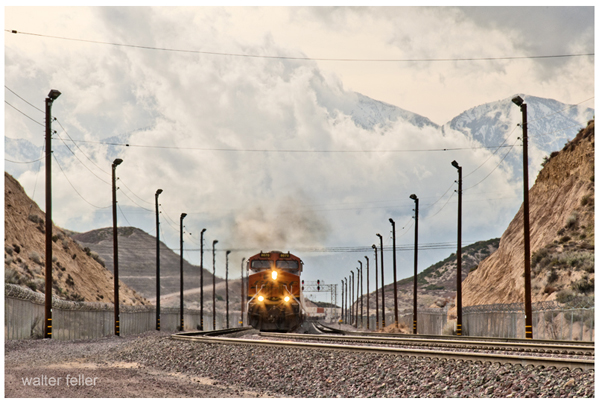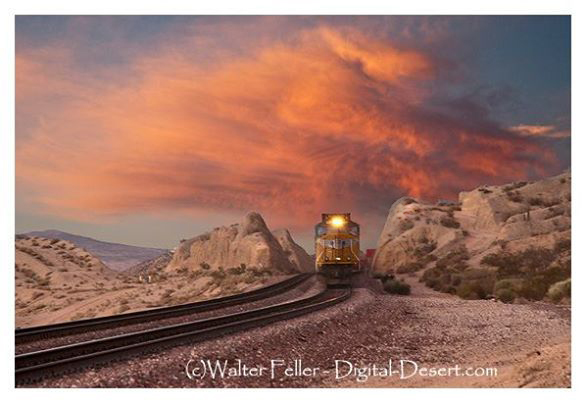The Coming of the Railroads
"The advent of the railroads saw the end of the stage coaches and of the freighting business. These held on tenaciously in some districts, local stages being in general operation until well into the '80s, while a few lines were still in existence as late as the start of the twentieth century , but the iron horse put a quietus on the stage business as a really profitable or important industry. From the very nature of things it was early evident that at some time a transcontinental railroad line would be put through from the lower Mississippi River to the Pacific Coast , and naturally there was much lively speculation as to what course it would take. San Diego, possessing a harbor, felt confident that it would be the recipient of the honor, while San Bernardino was equally confident, because of its great gateways of San Gorgonio and Cajon."
At first the railroad took over practically all the business in the way of freighting that it could handle, but the merchants of San Bernardino, after some figuring, found that goods could be shipped to Anaheim Landing by steamer and hauled from that point by mule team cheaper than they could be brought to Colton by the railroad , and the patronage thus given the " mule line" eventually caused the Southern Pacific to reduce its freight rates. In 1882 the California Southern Railroad reached Colton, and in 1883 the first train entered San Bernardino. Two years later the branch to Waterman was put through and San Bernardino thus secured a second transcontinental route.
~A Decade of Progress
History of San Bernardino & Riverside Counties - 1922

The "Salt Lake" Route
For years there has been almost constant talk of a connecting line of railway between Southern California and the Great Salt Lake Basin. In 1886, Captain C. E. Thorn, Judge Ross and otber property owners of Los Angeles built a narrow gauge line between Los Angeles and Glendale. About the same time Captain John Cross came from Arkansas and in company with other capitalists constructed a narrow gauge line between Los Angeles and Pasadena. This road absorbed the Los Angeles and Glendale line and was known as the "Cross" road. About 1890 it was confidently believed that the Union Pacific would at once complete the Utah Southern into California and would utilize some of the franchises already granted to enter this city. The same year a new railroad company was organized by St. Louis capitalists, which purchased the "Cross" roads and their franchises, bought 115 acres of land at San Pedro for terminal purposes and constructed a line from Los Angeles to San Pedro which was known as the "Terminal" road. It was then believed that this line was intended as a part of a Salt Lake route. But all the hopes and the unending newspaper rumors proved idle.It was not until Senator W. A. Clark, of Montana, became the moving spirit of a new company organized in the fall of 1900, which purchased the old "Terminal" road and also bought portions of the lines of the Oregon Short Line Railway Co., that there was any definite move toward the fulfillment of the project. For the past three years plans have been formulating and for two years past work has progressed rapidly on the Salt Lake route. The old roadbed between San Pedro and Los Angeles has been rebuilt. Extensive improvements at San Pedro have been undertaken ; a roadbed between Los Angeles and Riverside is completed and regular train service is now maintained. Arrangements have been made with the Santa Fe and the Southern Pacific to give the new line entrance into Colton and San Bernardino, and trackage to Daggett. From that point road building across the desert to meet the northern end of the line which extends from Caliente, Nevada, to Daggett. California, is well under way and will be finished by January i, 1905. For the past year neither men nor money have been spared, and no road in all the record of railroad building has ever been pushed through so difficult a country with such rapidity.
From Daggett the line follows the contour of the Mojave river for sixty-five miles, then turns across the Colorado Canon, passing through the "Cave country." Many tunnels, bridges and trestles are necessary through this wildly picturesque region. The route will be notable indeed for the weird beauty of its desert and mountain scenery.
It follows closely the old "Salt Lake Trail," first traversed by Captain Jefferson Hunt in 1847, and broken by the little band of the Mormon Battalion who, in 1848, drove the first ox-team through the Cajon Pass on their way to the new "City of Zion" in the Salt Lake Basin. Strange tales of bloodshed, of iron courage; of starvation and of rescue; of mines found and lost; of Spanish explorers and Indian tribes, of trappers, hunters, of prospectors and of religious fanatics are mingled with the history of this "Salt Lake" or "Mormon" trail. What thoughts must overwhelm the few old "mule-whackers" and pioneers of this trail now living,—what tales must come to their minds as they see palatial trains flying over the carefully ballasted and graded roadbed and making the journey in twenty-four hours that once required weeks of sturdy, unflinching endurance.
The road-bed and the equipment of the "Salt Lake" route is the most complete possible ; the buildings, stations, etc., are of the finest architecture and the most substantial character. The concrete bridge across the Santa Ana, near Riverside, is the largest concrete bridge in the world, being 980 feet in length, with eight arches, sixty feet above the river bed, while the foundations rest on rock from twelve to thirty feet below the surface of the ground. 30,000 tons of concrete were used in constructing this bridge which is a marvel of engineering.
The completion of this line will give to Southern California a third transcontinental route. It will open another large section of San Bernardino's desert area, thus bringing vast mineral deposits which have hitherto been unavailable, into requisition. New industries and new settlements will inevitably follow the establishment of the new line. More than 125 miles of track will pass through a portion of the county hitherto almost unattainable.
The junction of three great lines at Colton and San Bernardino will give an added impetus to these towns. New trackage and storage facilities will be required. It is likely that the repairing, etc., will for a time, at least, be done at the Santa Fe shops. Already these cities are growing with a rapidity unknown since the days of the "boom."
from; Ingersoll's century annals of San Bernardino County, 1769-1904 (Pg271-272)
-